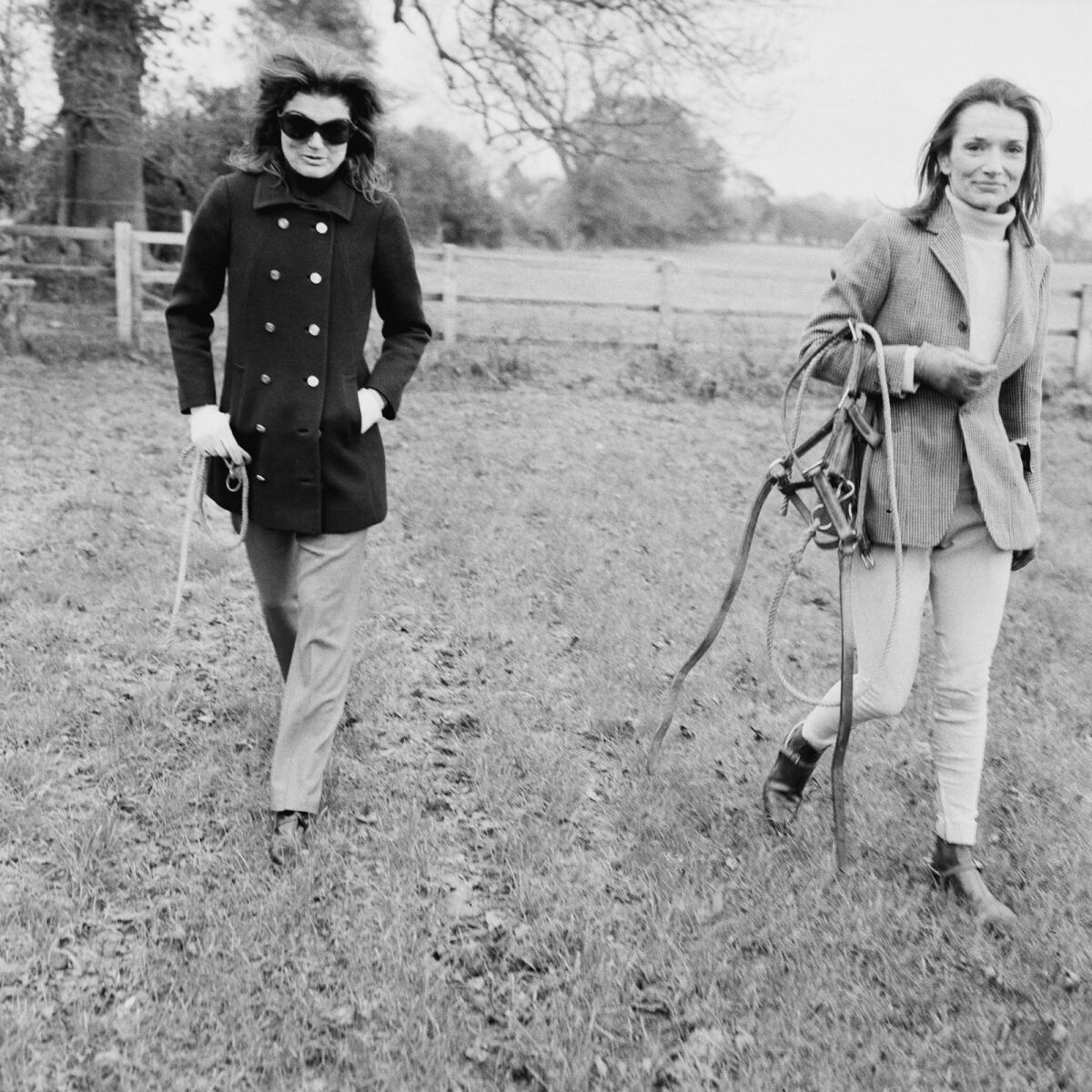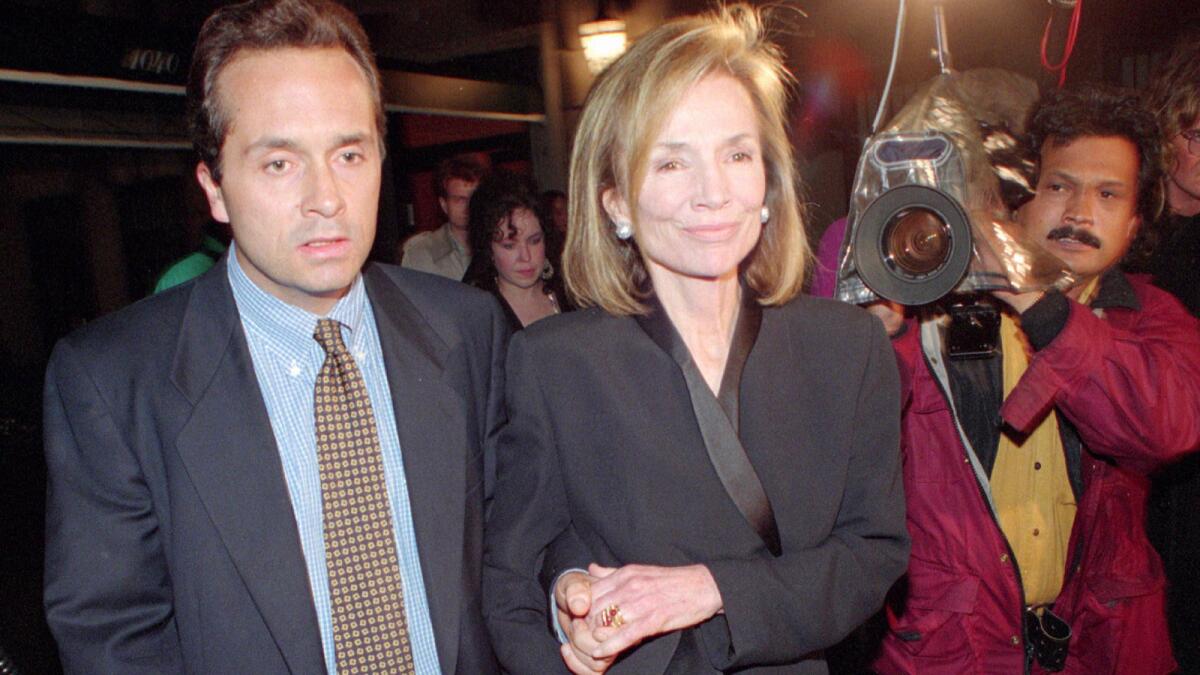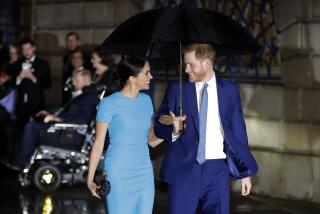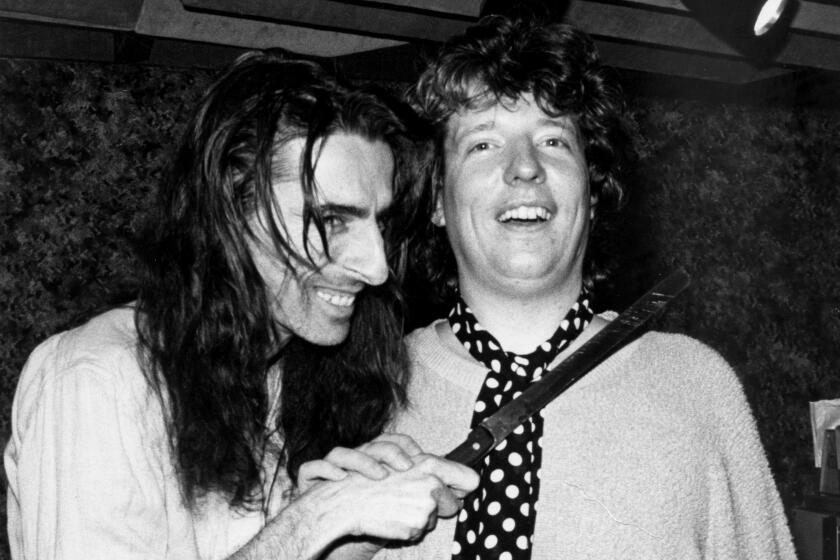Lee Radziwill, society grande dame and sister of Jacqueline Kennedy Onassis, dies at 85
- Share via
Lee Radziwill, who parlayed her cachet as the younger sister of former first lady Jacqueline Kennedy Onassis into a varied career as a fashion tastemaker, interior decorator, actress, princess and grande dame of cafe society on two continents, died Feb. 15 in New York. She was 85.
The death was confirmed by Cornelia Guest, a close friend. No other details were available.
Brought up amid great wealth in the Bouvier and Auchincloss families, Radziwill was raised with her sister in mansions along the East Coast.
Though she famously floundered as an actress, her adventurous spirit, sophisticated looks, husky voice and glamorous association with the Kennedy White House put her on magazine covers and televisions while opening doors to royal palaces, gala soirees, torrid romances and touchstone events of the 1960s and ’70s.
She obtained the title of princess after exchanging vows with an exiled Polish nobleman, her second of three husbands, but her most enduring influence was as a queen of style. Even before her sister, who’d married John F. Kennedy, became first lady in 1961, the fashion press had taken note of Radziwill’s chic looks that often featured clean lines, oversize sunglasses and free-flowing hair. Vogue magazine credited her with helping U.S. fashion transition from the stodgy elegance of the 1950s to a more relaxed and confident style.
She worked as an assistant to longtime Harper’s Bazaar editor Diana Vreeland, ran the American fashion pavilion at the 1958 World’s Fair and inspired designers such as Yves Saint Laurent and Marc Jacobs.
Writer Truman Capote said she outshone her more-famous sister. “She’s all the things people give Jackie credit for,” he told People magazine in 1976. “All the looks, style, taste — Jackie never had them at all, and yet it was Lee who lived in the shadow.”
Gossip columnists and books, including Diana DuBois’ 1995 unauthorized biography “In Her Sister’s Shadow: An Intimate Biography of Lee Radziwill,” insisted she was forever jealous of her internationally revered sibling.

DuBois even said Greek shipping magnate Aristotle Onassis, who married Jacqueline after President Kennedy was assassinated, was originally Radziwill’s conquest until the day in 1963 when she invited her sister along to sail on his yacht.
Onassis “was dynamic, irrational — cruel, I suppose — but fascinating,” she told the New York Times in 2013. “He also had the most beautiful skin, and smelled wonderful. Naturally, I mean. Fascinating ... as my sister discovered!” Radziwill always denied a rivalry.
During the Kennedy administration, the two sisters were confidants and traveling companions. They dined at Buckingham Palace and toured India, riding elephants and hobnobbing with Prime Minister Jawaharlal Nehru. Radziwill spent much of the Cuban missile crisis holed up in the White House with Jacqueline and watching the president exchange tense phone calls with aides.
“I can’t deny those few years were glamorous, being on the presidential yacht for the America’s Cup races, the parties with the White House en fête. It was so ravishing,” she told the Times.
By the time of Kennedy’s assassination in November 1963, she was an A-list socialite in her own right and often called Princess Radziwill thanks to her marriage in 1959 to Prince Stanislas Albert “Stash” Radziwill, who had fled Poland after World War II to become a London real estate developer.
She danced at Capote’s legendary Black and White masquerade ball in 1966, sometimes called “the party of the century,” and joined other celebrity hangers-on during the Rolling Stones’ infamously debauched 1972 U.S. tour. Lead guitarist Keith Richards, who was unimpressed, dubbed her “Princess Radish.”
Always restless, Radziwill, as People magazine put it, tried “on careers like so many Halstons.”
With Capote providing acting tips and Saint Laurent a rack of dresses, Radziwill debuted in a 1967 Chicago stage production of “The Philadelphia Story.” She played snooty socialite Tracy Lord, a role made famous by Katharine Hepburn, but critics panned her performance as stilted. “A star is not born,” one reviewer noted.
None of this dimmed Radziwill’s allure in high society. Her pencil-thin physique, long neck and elongated mouth graced magazine covers and photographs by Richard Avedon. Another friend, Andy Warhol, captured her elegance in an orange silk-screen portrait. Her closest friend was Russian ballet superstar Rudolf Nureyev, and she was romantically linked to other dashing men of the era, including architect Richard Meier and photographer and artist Peter Beard.
In 1976, she set up an interior decorating business in New York with a contract to design suites for Americana Hotels. She also worked as an event planner and style counselor to Giorgio Armani and was a fixture on the cocktail-party and fashion-show circuits of London, Paris and New York. Even into her 80s, Radziwill was making best-dressed lists while her expensively outfitted apartments were featured in architecture and design magazines.
“For more than a half-century, she was a central figure in the comings and goings of high society,” Vogue magazine wrote in a 2014 tribute. “A story about the frivolity of the 20th century should obligatorily dedicate at least one full chapter and numerous scattered mentions to Lee Radziwill.”
Radziwill was born Caroline Lee Bouvier in New York on March 3, 1933. Her father, John “Black Jack” Bouvier III, was a wealthy stockbroker notorious for womanizing and heavy drinking. Her mother, Janet Norton Lee, hailed from a prominent Southern family.

After divorcing, her mother remarried in 1942 to Washington businessman and Standard Oil heir Hugh Auchincloss Jr., stepfather of author Gore Vidal.
The Bouvier sisters, raised in large part by governesses, attended the private Miss Porter’s School in Farmington, Conn. Unhappy after her parents’ divorce, the future princess said she grew so lonely that at age 11 she tried to adopt an orphan.
She said her parents doted on Jacqueline, who was four years older, a bookworm and a better equestrian, while Lee, who was once thrown from a horse and trampled, was afraid of the animals. “My mother endlessly told me I was too fat, that I wasn’t a patch on my sister,” she told the Times.
But, like her sister, Lee was considered a classic beauty and named debutante of the year by the Hearst newspaper chain. She enrolled at Sarah Lawrence College north of New York City after her 1950 graduation from Miss Porter’s, but, professing a strong dislike for academics, left after her sophomore year to study art in Italy.
Her first marriage, to Michael Canfield, son of book publishing executive Cass Canfield, collapsed in part because of his reported heavy drinking and her burgeoning relationship with future husband Prince Radziwill. The Radziwills would divorce in 1974.
In 1988, she married film director and choreographer Herbert Ross, later telling the New York Times, “He was certainly different from anybody else I’d been involved with, and the film world sounded exciting. Well, it wasn’t.” She also said he’d been obsessed with the design tastes of his late wife, ballerina Nora Kaye. Radziwill and Ross divorced in 2001, shortly before his death.
She had two children with Prince Radziwill. Their son, Emmy Award-winning TV news producer Anthony Radziwill, died of a rare form of cancer in 1999 just weeks after her nephew, John F. Kennedy Jr., with whom she was close, died in a plane crash. Survivors include a daughter, Anna Christina “Tina” Radziwill. Information on other survivors was not immediately available.
Forever linked to the former first lady, Radziwill once told People that she had forged her own identity.
“I’ve been far more successful than I ever imagined,” she said. “I’m nobody’s kid sister.”
More to Read
Start your day right
Sign up for Essential California for the L.A. Times biggest news, features and recommendations in your inbox six days a week.
You may occasionally receive promotional content from the Los Angeles Times.






